Pools
Form – Smart Swim Goggles Use AR Technology
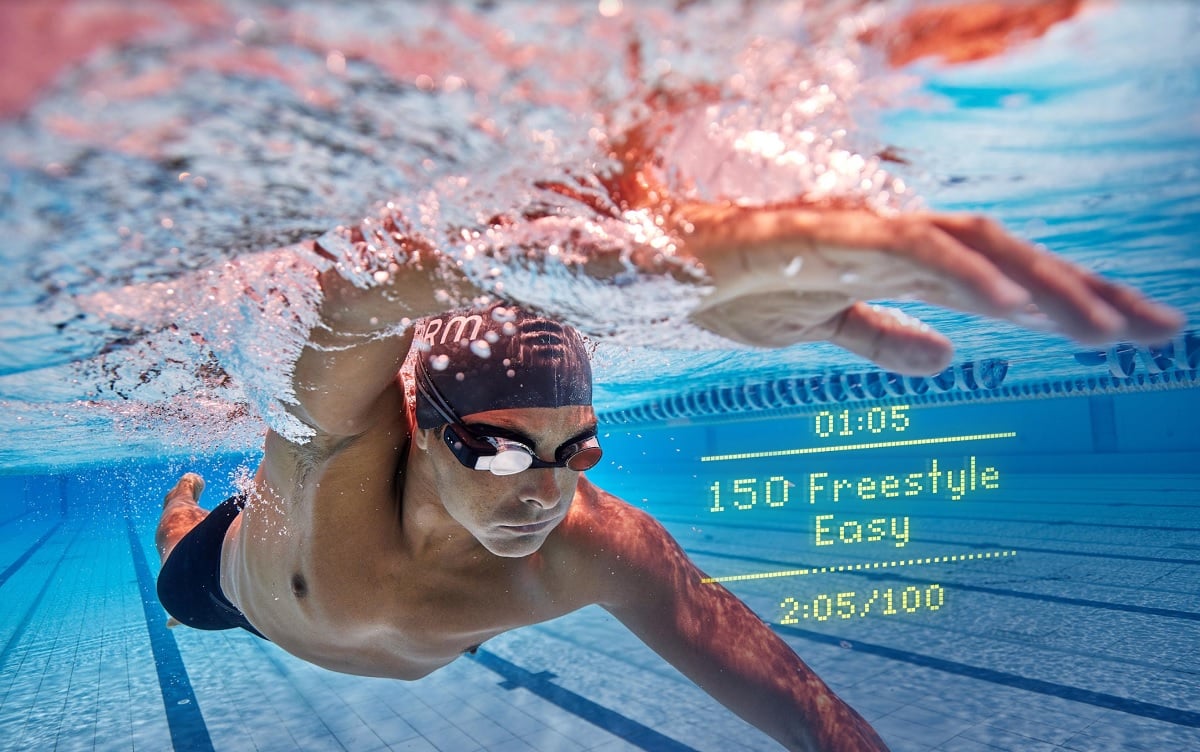
Form smart swim goggles are the first swimming goggles with a heads up display. This revolutionary new smart goggle is taking the swim world by storm. The product represents an incredible leap forward with advancements in the field of Augmented Reality (AR) technology which have finally made their way to the swimming pool. We recently had the chance to have an in-depth interview with the Founder and CEO of Form, Dan Eisenhardt, and discussed the product in great detail on the Pool Magazine Podcast.
Eisenhardt, who hails from a family of swimmers in Aalborg, Denmark – has always had a passion for swimming. In fact, he swam competitively himself for 14 years prior to starting his career as a sports technology entrepreneur. “I started swimming at a young age. My dad and his brothers were swimmers, my grandfather was a swimmer,” said Eisenhardt, “so that was always interesting to have those discussions around the dinner table.”

As he got older, swimming remained a passion with Eisenhardt. He swam competitively and won NJCAA All-American honors while swimming for Indian River State College in Florida. While pursuing a degree in mechanical engineering, he also developed an interest in entrepreneurship. He would ultimately decide to go for his MBA at the University of British Columbia.
It was this decision that would set the stage for coming up with the initial concept for what would eventually one day become Form. “There was an entrepreneurship class I was taking and the first thing we had to do was come up with an idea for a business,” said Eisenhardt, “since I was passionate about swimming and engineering, I came up with an idea for a swim goggle with a heads up display that could show you metrics in real-time.”

For Eisenhardt, it was the answer to a problem that had always plagued him as a competitive swimmer. “I always struggled with not having that as a swimmer, being in the pool, and not being able to see the clock. It seemed either my goggles were always fogging up there was someone standing in front of the clock and I’d have to do the mental math of when I left and when I came in.”
The timing for such an invention may not have been right for Eisenhardt back in his MBA days. “I pitched the idea back in 2006, this is before the iPhone was launched. A bunch of people came up and said ‘this sounds really cool but do you know how to build it?'”, said Eisenhardt, “I said ‘I have no idea if it really can be built but it would be cool if it existed’. So off we went and became a group.”
It was during these initial explorations into the feasibility of the product that Eisenhardt knew that he was ahead of his time with the concept, “I quickly realized it was too difficult to pull off as a swimming goggle at that stage the miniaturization, the environment, the sensor technology just wasn’t mature enough,” said Eisenhardt, “We ended up building a similar product into a pair of ski goggles so you could see how fast you were going, you could get text messages while you were skiing and resort maps in your goggles.”
“That became a company called Recon Instruments,” explained Eisenhardt, “we built 5 generations of that product before we sold it to Intel in 2015. We launched the first product in 2010. We were sort of the Intel inside of the action sports industry, we called ourselves and then we wound up selling to Intel which is kind of funny. Our biggest customers were the eyewear brands like Oakley, Smith, Uvex, and Scott and all those big brands. They adopted our technology as a modular solution that fit into their goggles. We sold to them and eventually developed our own cycling glasses with a heads-up solution. That’s where we started and got a lot of expertise and then Form benefitted greatly from that expertise.”
The success of that product launch and eventual sale would spur Eisenhardt to pursue his original concept of a smart swim goggle. “After that happened I went straight back to my initial idea because now the technology was mature and I had all this experience,” said Eisenhardt, “I launched my new company Form, and three years later we launched the first product which are the form swim goggles with the heads up display.”

The decision to backtrack to these earlier years and revisit the swim goggle product is one that had come full circle for the innovator. Coming up with a superior product in the swim goggle space is an objective Eisenhardt considered his personal mission to achieve. A feeling of unfinished business and that the stars had finally aligned for this type of product would inevitably be what propelled the innovation that has become the Form goggles.
“I always thought the killer app for swimming was AR because there was no alternatives. There is nothing in swimming that can give you the real time information without the tradeoffs. I really thought it was unfinished and I wanted to go back to that starting point.”

Building the ultimate app for swimmers would involve finding the right people to help execute in the application design. “When you talk about AR, it’s a completely new category. It’s very different from developing other types of products. The hardware is potentially not the biggest constraint, it’s more of the killer app that runs on the hardware, or the business model. Here we’re still early on in AR, it’s taken a long time because it’s a difficult problem to solve.”
Eisenhardt suggested the challenge of putting technology in front of people’s eyes had constraints beyond mere engineering hurdles. Other early AR devices like Google Glass had failed because of the social stigma of wearable tech. Beyond that, the overall look and feel of the technology created a usability matrix of problems for Form to solve with their product.
It was through iteration prototyping that Eisenhardt would come up with the perfect balance for the Form swim goggles. Determining what was feasible was important, “we said what can we do from a hardware perspective, where can we position electronics, how much information can we actually show when you’re swimming and how can we dumb it down so that it doesn’t actually distract you.” In discussing the technology, Eisenhardt gave us an overview.
“The product works on a nine-axis sensor in the goggles, incorporating a (3-axis) accelerometer, (3-axis) gyroscope, and (3-axis) magnetometer into the wearable device,” explained Eisenhard.

All of these sophisticated sensors work in tandem with a machine learning technology Form has spent years developing with swimmers of all types of backgrounds and skillsets. This enables the device to be able to determine what swimmers are doing in the pool automatically.
“The device knows if you’re resting or swimming. If you’re swimming it knows what stroke type and how fast you’re going,” said Eisenhardt, “those core metrics our machine learning takes care of. Then we’ve got all sorts of other features that will calculate your last length pace and your stroke rate, distance per stroke, and all sorts of other metrics.”
“The overhead display chain uses a freeform optics wave guide which guides the light from a micro OLED display. This hits a beam splitter which sends the image directly to your eye so you see a virtual image that is always in focus,” explained Eisenhardt.
Getting accurate information that would provide swimmers with meaningful data to improve their performance was vital in getting competitive swimmers to embrace the product. Providing them with a 1-to-1 ratio of what was going on in the pool and giving them real-time data has been what has made the Form product a smashing success with triathletes, competitive, and recreational swimmers.
Getting the device to spit back the real-time metrics that was important to swimmers was something Eisenhardt worked painstakingly to get right, “We spent some time on that and the metrics that are important is different depending on what type of swimmer you are,” said Eisenhardt, “typically you want to be able to see your pace per 100, how fast you’re swimming, how far you’ve gone, a length counter or lap counter.”
The device also allows swimmers to see how they perform over time. “You want to be able to see your split times so you can compare current length over the last length, your heart rate, and so forth,” explained Eisenhardt.

Form swim goggles allow for custom configurations based on the data you want to see in real-time with three different contexts including Swimming, Stroking, and Turning. These aspects allow different data sets of information to appear on the heads-up display as they occur. All of this incredible data allows swimmers to have better visibility of their stats in the pool. The device is being touted as the swim coach’s assistant, given that the 10,000-foot data the goggles provide gives trainers better insight into swimmer performance.
Listen to our entire interview with Dan Eisenhardt and learn more about Form smart swim goggles on the Pool Magazine podcast.
Pools
In-Pool Furniture and Fire Feature Trends: What’s Hot in Outdoor Living
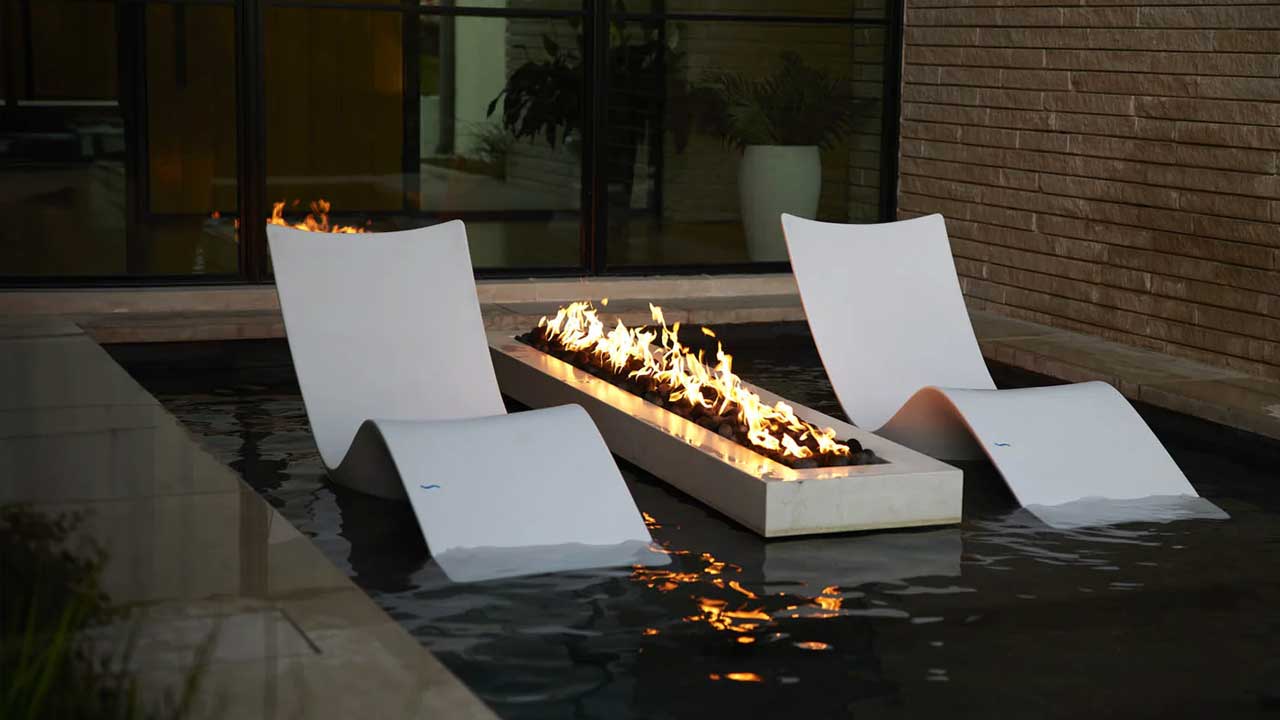
As outdoor living spaces continue to evolve into true extensions of the home, homeowners are increasingly seeking luxury, function, and style in every element of their backyard designs. This year, in-pool furniture and fire features are taking center stage as two of the most in-demand trends, transforming pool decks and sun shelves into five-star resort-style environments. To get an expert perspective, we sat down with Frank Vitori of AquaBlu Mosaics, one of the most trusted voices in poolside accessories.
2 Hot Trends for 2025: In-Pool Furniture & Fire Features
Mass Adoption of Sun Shelves Sparks an In-Pool Furniture Revolution
Frank Vitori credits the meteoric rise of in-pool furniture to the widespread popularity of the sun shelf, also known as the Baja shelf. “Over 90% of modern custom inground pools are now being built with a sun shelf,” he shared. “People have come to realize that it’s not just a stylish design element—but a shallow-water hangout zone that brings comfort, safety, and versatility to families and guests.”
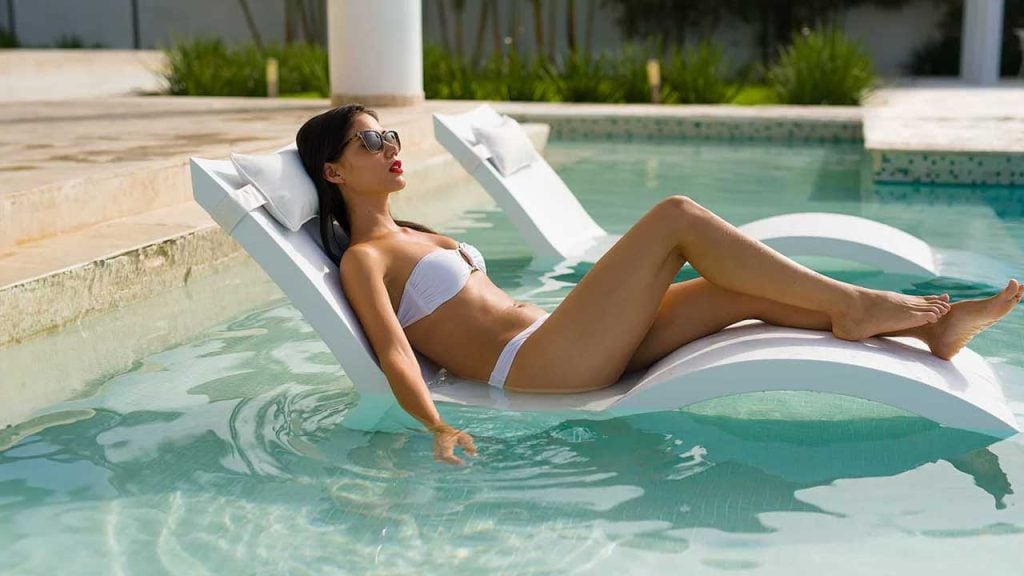
He points to industry innovators like Ledge Lounger, which helped define this category with their Signature Chaise. “I gotta give a lot of credit to Ledge Lounger and Chris Anderson for seeing the potential,” Vitori said. “They started with one chair at trade shows and now their products are part of nearly every luxury backyard.”

Following their example, brands like Floating Luxuries and Tenjam have entered the market with fresh takes. “Floating Luxuries came out with their Kai Collection, which is oversized, ergonomic, and super convenient to fill in place with a garden hose,” said Vitori. “Tenjam is another newer brand offering some exciting new designs for in-pool seating.”
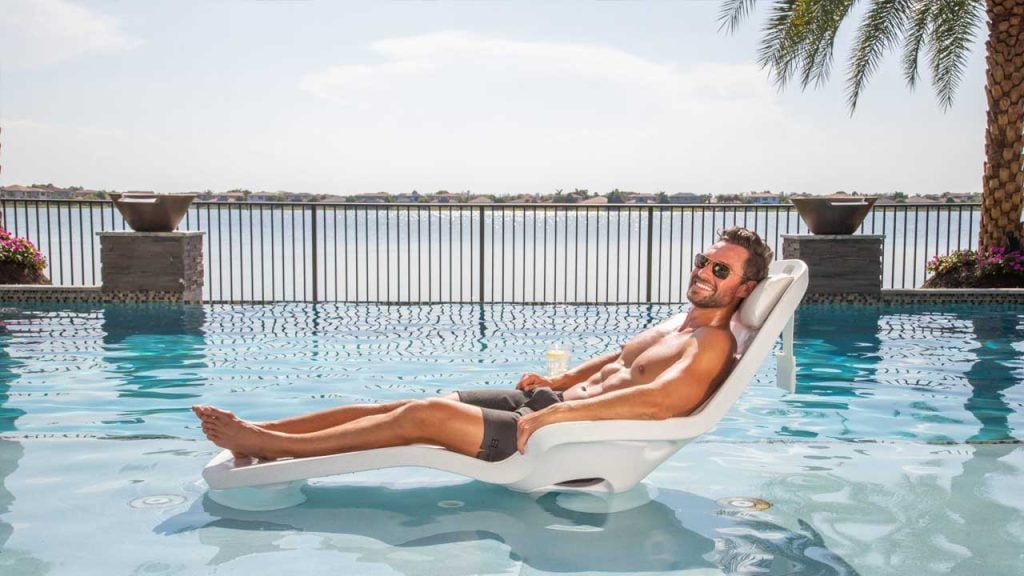
Studio Red Rock: Cast Concrete and Built to Last
One of the most distinctive product lines comes from Studio Red Rock, which specializes in cast concrete in-pool furniture. “These are heavy-duty, commercial-grade pieces that don’t need to be filled with water because they already weigh over 160 pounds,” explained Vitori. “That permanence is a big selling point for resorts and hospitality clients. Guests can’t drag the furniture around or damage it—once it’s in place, it stays put.”
Studio Red Rock’s modern silhouettes and durable finishes are turning heads, especially in high-end commercial settings and contemporary residential pools where maintenance and visual impact are both key.
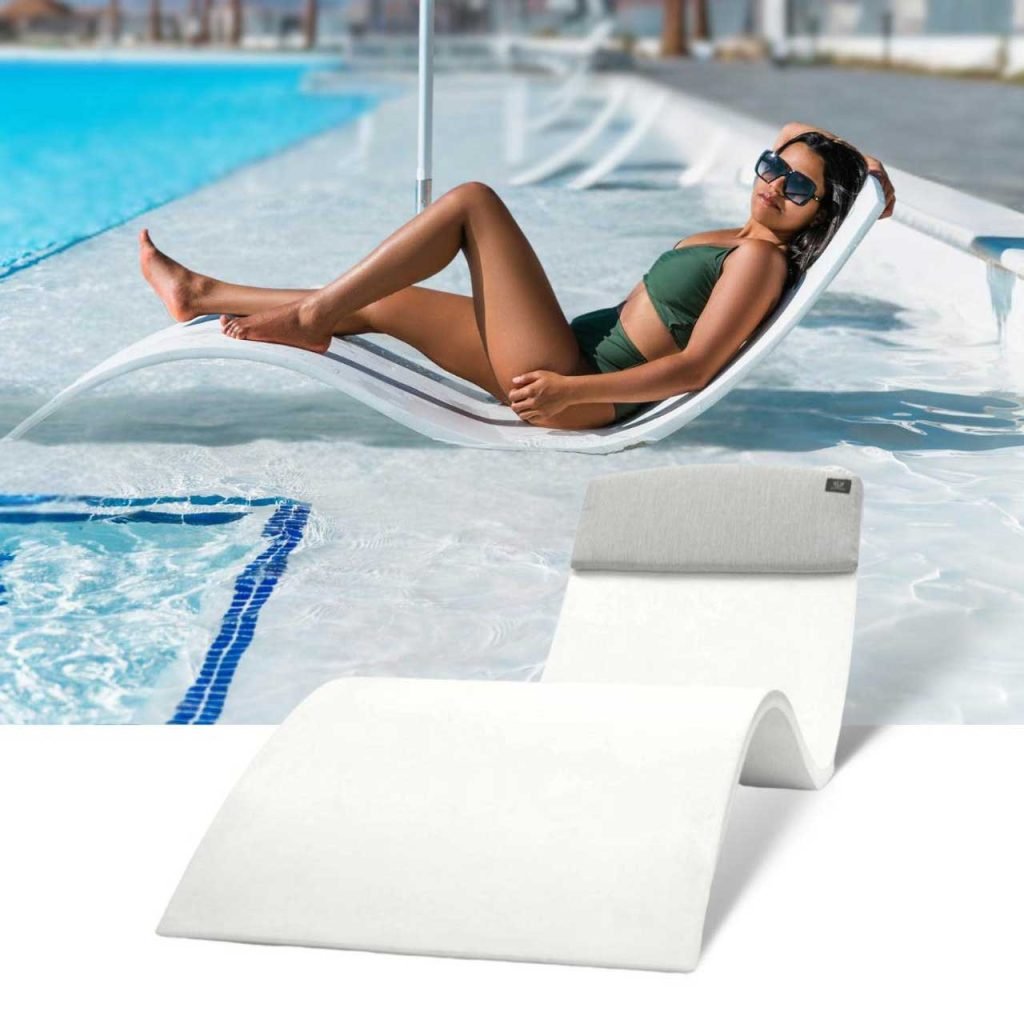
Sustainable Style Makes Waves
Sustainability is also gaining momentum in the outdoor furnishings space. European-style brands like Vondom are leading the way with eco-friendly materials, such as the Ibiza Collection made from recycled ocean plastics. “There’s no reason something sustainable has to be boring or unattractive,” said Vitori. “The Ibiza Collection is a great example of that—it’s stylish, high-quality, and it’s helping clean up the ocean. That’s a win-win.”
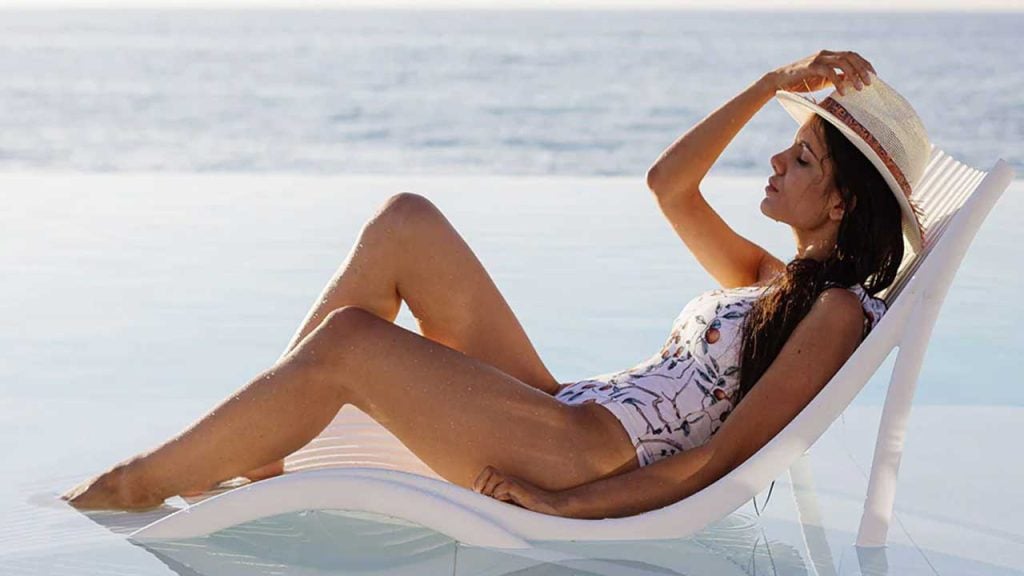
More and more, consumers are factoring sustainability into their design decisions, especially younger buyers who want their purchases to reflect their values.
Going Beyond the Chaise
It’s no longer just about the lounger. “We’re seeing more diversity in product offerings—rockers, modular sofas, side tables, even daybeds,” said Vitori. Ledge Lounger’s Affinity Collection is one example, offering ottomans and configurable seating that adapts to the size and shape of the sun shelf.
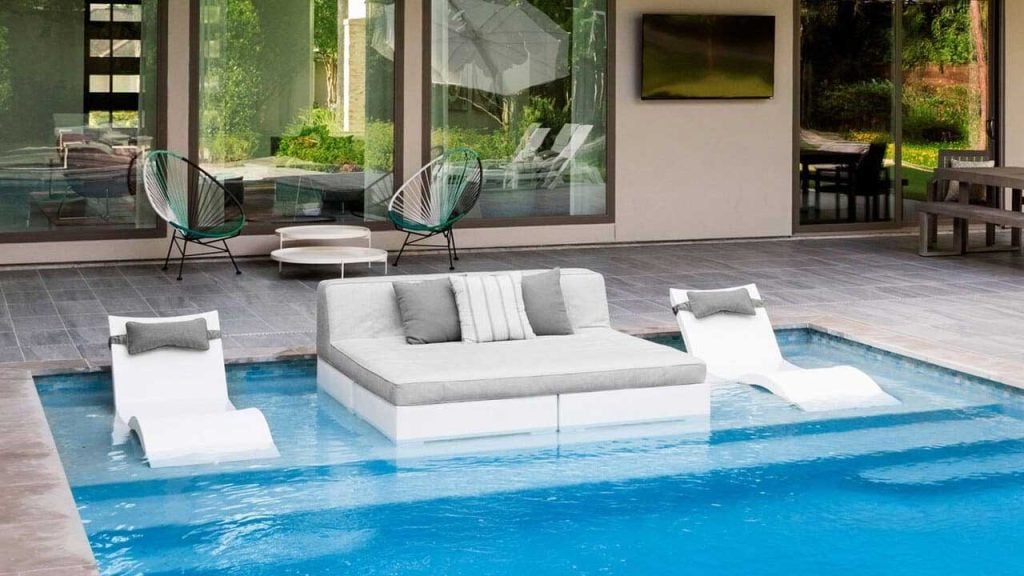
Some of the most underrated but impactful additions, according to Vitori, are accessories like tables with built-in ice buckets or umbrella holes. “It’s surprising how many people don’t realize that most in-pool furniture lines include coordinating side tables,” he said. “These tables often come with built-in ice bins and pre-drilled holes to accommodate umbrellas. That way, you’ve got a drink nearby, some shade overhead, and everything is cohesive.”
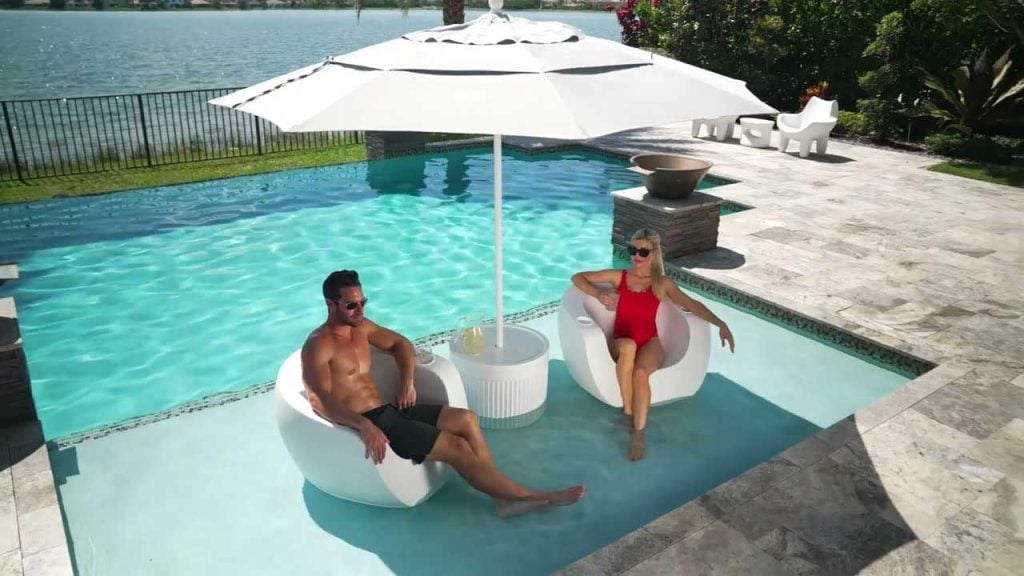
The Importance of Quality and Material
With in-pool furniture becoming a long-term investment, Vitori stresses the importance of selecting pieces made specifically for water use. UV resistance, structural stability, and chemical durability are essential. “There’s a lot of imitators out there now,” he warned. “Some of these cheaper versions you find online aren’t built for constant sun and chlorine exposure. They yellow, they crack, and they don’t hold up.”
Each brand has its own approach to water filling, anchoring, and material engineering. “Some have manual plugs, others you fill in the deep end. Floating Luxuries uses a hose and venting system that’s super easy to use. Every design has its pros and cons, so it’s worth talking to someone who knows the differences.”
Fire Features: A Focal Point of Year-Round Use
As homeowners look to make their outdoor spaces usable year-round, fire features are becoming a must-have. From compact fire pits to grand fire-and-water combinations, the market has expanded dramatically.
Vitori points to two standout manufacturers—Prism Hardscapes and The Outdoor Plus—as leaders in this category. “Prism Hardscapes specializes in GRFC cast concrete, offering that natural stone look. They’re sealed, color-through, and ready to ship,” he said.

In contrast, The Outdoor Plus brings more contemporary flair, with powder-coated stainless steel and hammered copper finishes. “The copper options age beautifully over time and add a real wow factor,” noted Vitori.
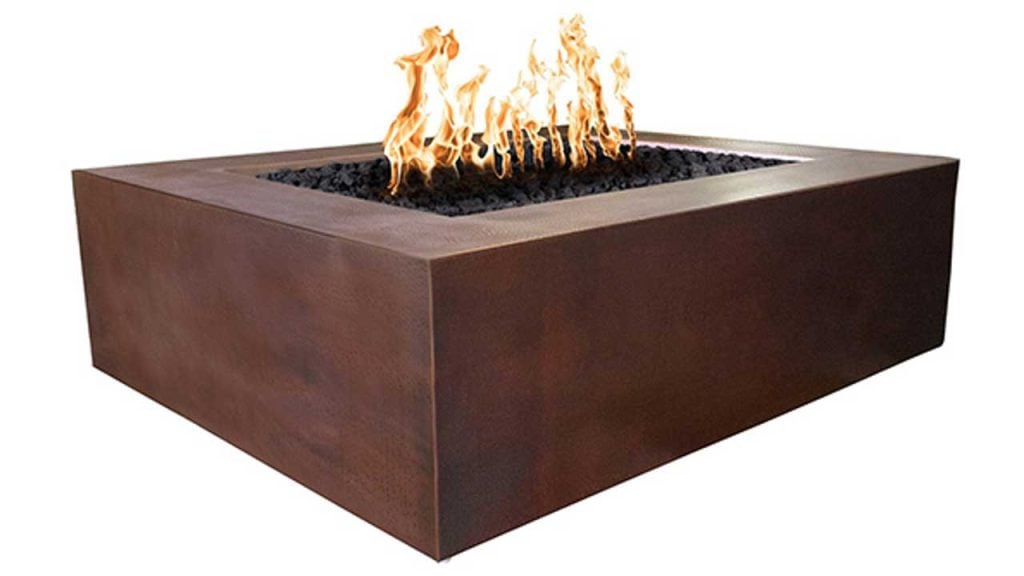
Innovative Designs Gaining Traction
One of the more eye-catching designs to hit the market recently is Prism Hardscapes’ Sunflower Fire Bowl. “It breaks the mold—literally. It’s a sculptural centerpiece that looks incredible on modern decks,” said Vitori.
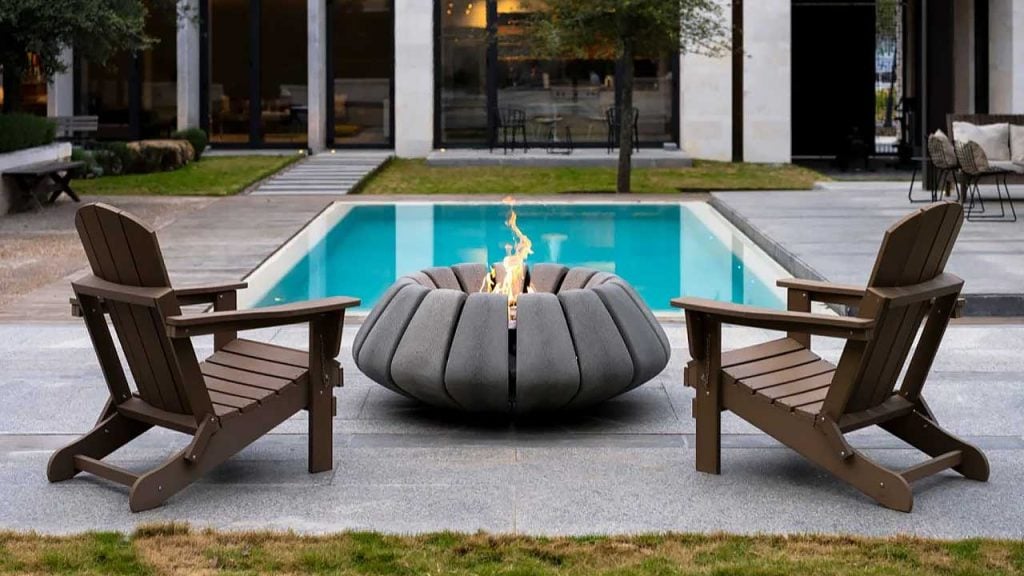
Another highlight from Prism is the Fairmont Table, which combines teak and concrete in a hybrid fire feature perfect for coastal designs.
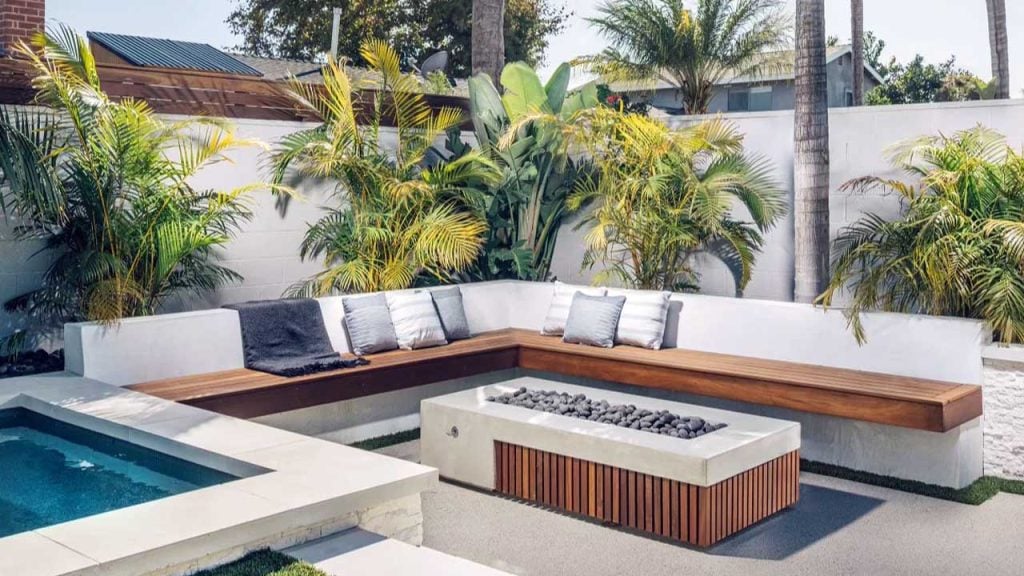
Ledge Lounger is also making a splash with their new Halo Fire Pit, a resin-based design that includes a hidden compartment for a compact propane tank and a rotating lid. “It’s ideal for the DIY crowd. No need to plumb gas—it’s turnkey,” said Vitori.
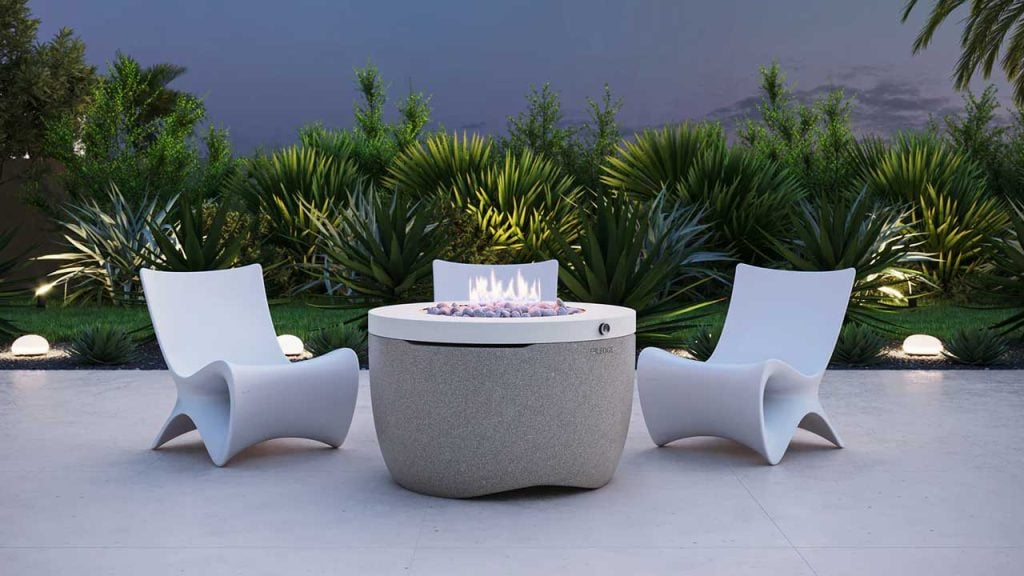
Fire & Water: A Visual Power Combo
The mix of fire and water is captivating, but it requires thoughtful integration. “These are usually not DIY installations,” Vitori said. “Fire and water bowls typically go on pedestals around the pool and are installed during the pool build.”
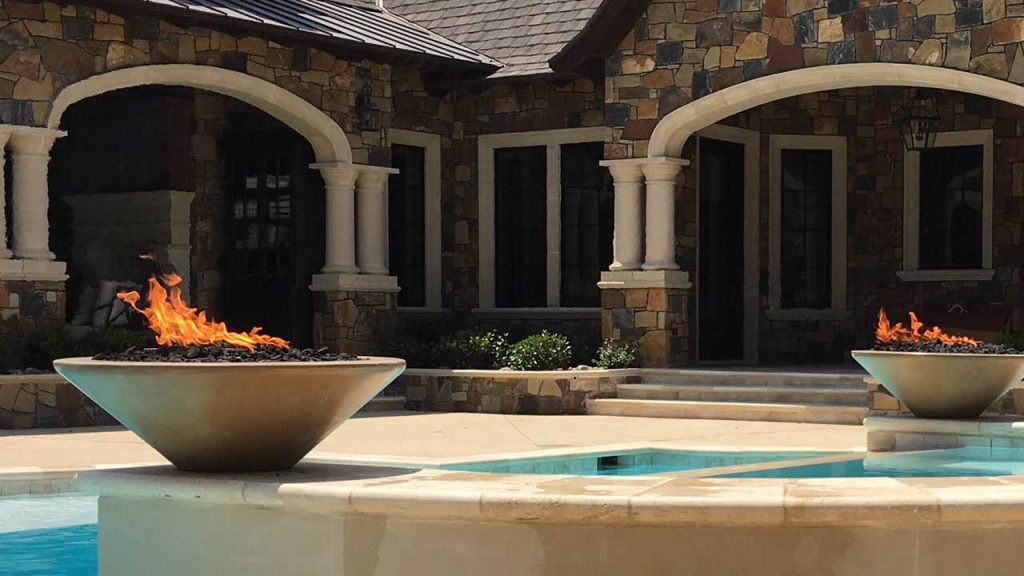
Standard models like the Cazo Bowl and Lombard are popular, but custom fabrications are on the rise. “We’re seeing more requests for 10-foot fire-and-water features, full automation, and custom pans and burner kits,” said Vitori. “Designers are pushing boundaries, and the manufacturers are stepping up to meet the demand.”
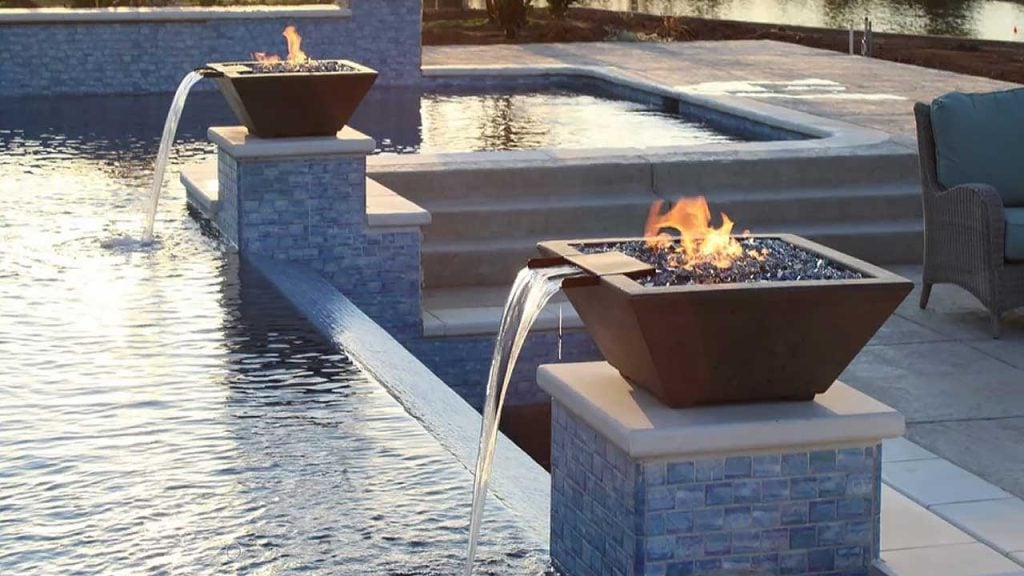
What It All Means for 2025
Fire features and in-pool furniture are more than just trendy add-ons—they’re reshaping how people live in and around their pools. “This year’s trends aren’t just about what looks good,” said Vitori. “They’re about designing for function, comfort, and usability—creating spaces that people want to live in, not just look at.”
Expect more innovation ahead as designers push for modularity, sustainability, and integration with smart systems. The modern poolscape isn’t just for summer—it’s becoming the heart of the home, all year long.
Article Photo Credits: Ledge Lounger, Tenjam, Studio Redrock, Floating Luxuries, Prism Hardscapes, The Outdoor Plus
Pool News
Pool Tile, Coping, and Kickflips: The Unique Lifestyle of Thiago Dasilva
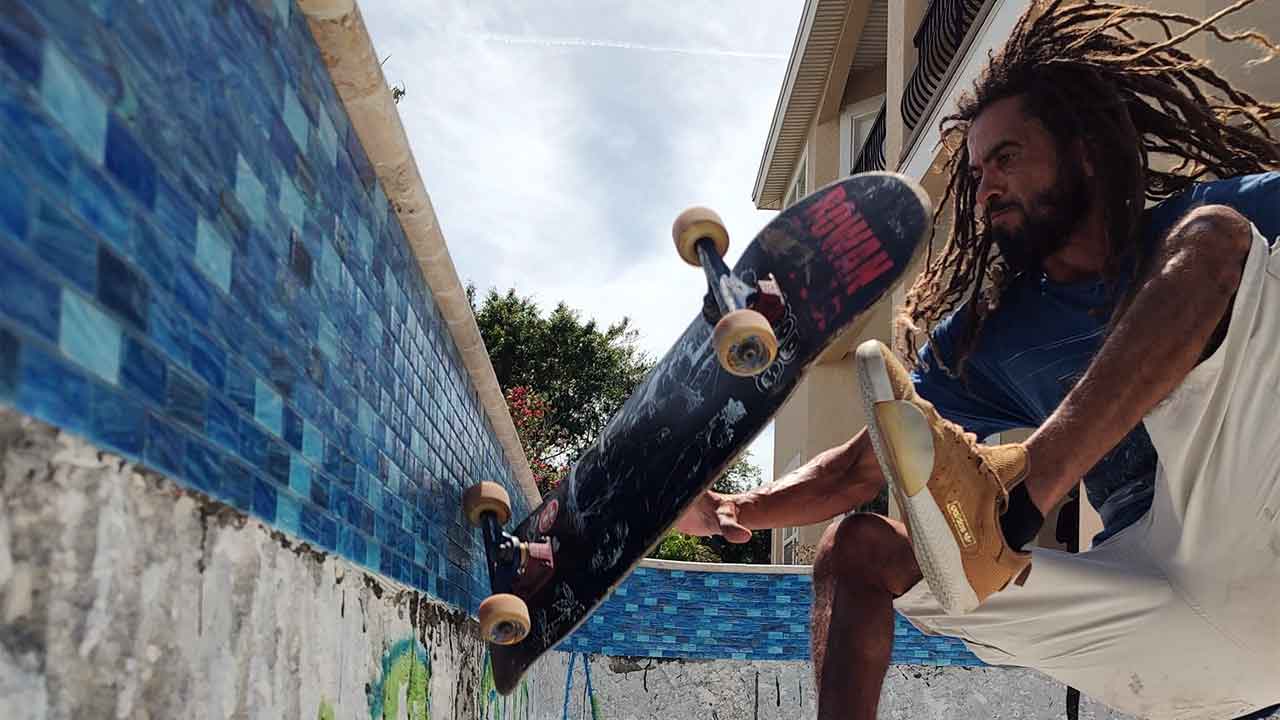
In Florida’s competitive pool construction scene, you’ll find a wide range of subcontractors—but few bring the same energy, attitude, and personal flair to the job as Thiago Dasilva. Originally from Brazil, Dasilva came to the U.S. looking to build a better life for himself and his family. Today, he owns and operates Greenstone Tile and Pavers, a small but busy operation where he stays hands-on with every project.
Dasilva isn’t the kind of guy who’s chasing status or running a big crew. He’s the one doing the work—installing tile, coping, and pavers on high-end residential pools throughout the Tampa Bay area. Contractors who need a solid installation often call on him, especially for more detailed jobs. If you’re following any of the pool industry Facebook groups, chances are pretty good that you’ve already seen some of his work.
Point of fact, we recently featured a Hampe Pools project during our Pool Magazine webinar on Tile Trends—an elegant, modern backyard design that drew attention for its vibrant mosaics and clean execution. Thiago Dasilva worked as an employee of Hampe Pools on that job, helping to bring that project across the finish line with precision.
Though he’s often brought in as a subcontractor, Dasilva takes pride in treating every job like it’s his own. Whether it’s a straightforward waterline or a complex glass mosaic, he approaches each project with the same goal, delivering high-quality work that both he and the builder can be proud of.
“I love seeing people smile when they see the completed job,” Dasilva told us. “That’s what makes me feel proud—when the homeowner is happy and the builder is satisfied with the result. That’s the greatest reward for me.”

Unlike some subcontractors who rush through work to move on to the next job, Dasilva believes in taking his time to get it right. He’s not interested in cutting corners or tackling too many projects at once. Instead, he focuses on delivering quality, one pool at a time.
“I don’t like to be all over the place,” he said. “I take my time. I don’t rush through the job. I care about what I’m doing.”
That mindset—coupled with his attention to detail—has made him a go-to name in a region where pool construction never slows down. He’s the type of installer builders can count on for a clean layout, tight grout lines, and an end result that lives up to the design.
When asked what separates a good installer from a great one, Dasilva answers without hesitation: “Compassion. You’ve got to care about what you do.”

Over the years, he’s had the opportunity to work alongside some of the best in the business, but he’s quick to give credit to those whose work has also influenced him.
“I’ve learned a lot from Jeff Hampe. On every job, I always learn something new. I’ve also learned a lot from observing the work of guys like Jimmy Reed, Ray Corral, Danilo Bonazza, and so many others,” he said. “I look up to all of them.”
But Dasilva has also seen his fair share of mistakes out in the field—work that may look okay on the surface but doesn’t hold up over time.
“I see people just putting mud straight against concrete without any thinset or bonding agent,” he explained. “That’s a big one. It might look fine at first, but later it cracks, separates, and causes problems. You have to prep properly or you’re setting yourself up for failure.”
He’s just as critical of rushed layouts and sloppy grout work. “You walk onto some jobs and you see tiny cuts in the tile that throw the whole thing off. It might be functional, but it’s not clean. That kind of stuff bothers me.”
One of the most challenging jobs he’s ever tackled involved a massive infinity-edge pool with custom mosaics across the floor—an intricate installation that took him nearly seven months to complete.

“There was a lot of slope and depth to deal with,” he said. “It was a challenge from start to finish, but I learned a lot on that job. When it was said and done, I felt incredibly proud of the work I did there.”
Despite the complexity of projects like that, Dasilva still finds joy in the everyday rhythm of the job. Whether it’s prepping the surface, setting tile, or double-checking a layout, he approaches each phase like a craftsman—even if he’s not the kind of guy who uses that word to describe himself.
While his tile work speaks for itself, there’s one detail about Dasilva that tends to surprise people: on rare occasions, he’ll drop into the pool with a skateboard before the job even begins.
For most tile installers, that empty concrete shell is just a workspace. For Dasilva, it’s sometimes a playground—at least when the shape is right.
“I grew up skateboarding back in Brazil,” he said. “It’s been a part of my life since I was six years old. So when I find a shell that’s got good curves and transitions—usually the old pools from the ’70s—I can’t resist. I bring the board out.”

It doesn’t happen on every job. In fact, he says it only happens maybe once or twice a year when the opportunity presents itself. But when it does, it’s a chance to reconnect with something that still brings him joy.
“I feel like a kid walking into a candy store,” he laughed. “It just makes me happy. And believe it or not, skating the shell actually helps me find hollow spots or imperfections in the surface. So it’s fun—but it’s useful too.”
His posts on Facebook—blending clips of him carving around the bowl with shots of precise tile installs—have earned him a following among pool pros who appreciate both the quality of his work and the personality behind it.
“Yeah, some people think it’s crazy,” he said. “But it’s who I am. I’m still skating. I’m 43 now, and I’m still doing it.”
For Dasilva, it all comes down to work-life balance. He’s not chasing money or awards. He’s focused on doing honest work, staying hands-on, and improving with every pool he touches. “I’m not trying to be the biggest company,” he said. “I just want to do good work, take care of my family, and enjoy what I do.”
When he’s not working, he’s usually with his wife and kids—or sneaking in a skate or surfing session whenever he’s not on the clock. It’s a lifestyle that blends hard work with personal passion, and one that’s earned him quiet respect in an industry that doesn’t hand it out easily. “I feel like I live in paradise,” he said. “I get to work outside, build something beautiful, and have fun doing it.” In his own way, Thiago Dasilva is proof that you don’t have to run a big crew to make a big impression—you just have to be passionate about what you do.
Photo Credits: Thiago Dasilva, Jeff Hampe
Pools
Happy National Pool Opening Day!
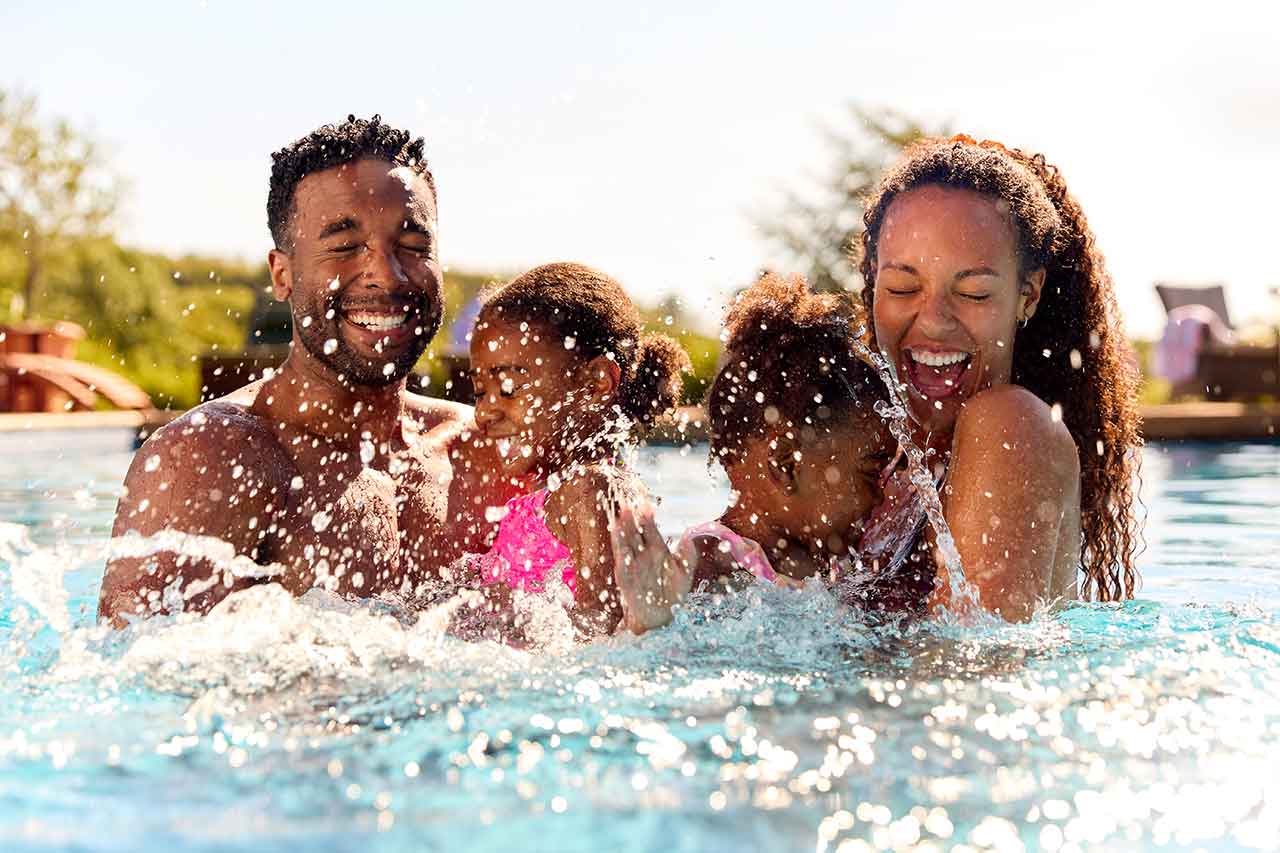
Each year, the last Saturday in April marks the unofficial official start of swim season with National Pool Opening Day — falling on April 26th this year. Across the country, pool owners celebrate by pulling back their covers, breaking out their test kits, and getting ready to make a splash. It’s the perfect reminder that summer fun is just around the corner — and that now’s the time to get your pool prepped for a stress-free season of relaxation and enjoyment.
Where you live often determines how (and when) you celebrate National Pool Opening Day. Here’s a quick look at typical pool opening schedules across the country:
| Region | Typical Pool Opening | Notes |
|---|---|---|
| Florida, Texas, Arizona, SoCal | March to Early April | Early openers; swim season often starts before National Pool Opening Day |
| South Florida, Hawaii, Coastal SoCal | Open Year-Round | Pools rarely close; celebration is more ceremonial |
| Northeast (NY, NJ, MA, PA) | May to Early June | Later start due to lingering cold weather |
| Midwest (IL, OH, MI, MN) | May to Early June | Wait for consistent warm temperatures |
| Pacific Northwest (WA, OR) | Late May to June | Cooler spring weather often delays opening |
| Mountain States (CO, UT, ID) | Late May to June | Higher elevations mean a shorter pool season |
No matter when you decide to open your pool, Pool Magazine has you covered with expert advice to ensure everything goes smoothly.
The ideal time to open your swimming pool depends mostly on weather, water temperature, and algae prevention — but here’s the general rule:
When daytime temperatures consistently stay above 70°F (21°C), it’s time to open your pool.
Here’s why that’s the sweet spot:
- Prevent algae growth: As the water warms up in spring, algae can start to bloom under the pool cover. Opening earlier lets you treat and circulate the water before it turns green.
- Easier water balancing: It’s much easier (and cheaper) to get your water chemistry right when the pool hasn’t turned into a swamp yet.
- Extend your season: Even if you don’t swim right away, getting the pool open early means you’ll enjoy a longer, cleaner season — and your backyard will start looking summer-ready.
- Beat the service rush: Spring is less crazy than the early-summer rush for pool openings.
Start With Basic Pool Maintenance
Begin with some essential maintenance tasks to set the stage for a clean and trouble-free swim season:
- Remove the cover carefully and clean it thoroughly before storing it away.
- Top off the water level if it’s dropped during the off-season.
- Skim off leaves and debris that may have gotten into the pool.
- Brush the pool walls and floor to eliminate dirt and prevent algae growth.
- Vacuum the pool thoroughly to remove any lingering sediment.
- Test and balance the water chemistry, including pH, alkalinity, calcium hardness, and chlorine levels.
Don’t Forget About Pool Equipment
Before running your system, it’s important to give your pool equipment a once-over. Inspect your pumps, filters, heaters, and chlorinators for any signs of wear, leaks, or winter damage. Lubricate O-rings if needed and replace any brittle or cracked gaskets. Make sure the pump is properly primed and the water is circulating correctly.
While you’re at it, it’s a smart idea to schedule a professional pool inspection to ensure everything is running smoothly. A trained eye can catch small problems before they turn into major repairs during the peak of summer. And if opening your pool feels like it’s more than you want to take on yourself, this is the perfect time to book a professional pool opening service as well. They can handle everything from chemical balancing to equipment startup, giving you peace of mind that your pool is ready for the season ahead.

Plan Ahead for a Stress-Free Summer
To enjoy a seamless swim season, a little preparation goes a long way. Here are some simple tips:
- Stock up on essential chemicals like chlorine, pH balancers, and algaecide before the summer rush.
- Purchase backup parts like skimmer baskets, O-rings, and filter cartridges to avoid mid-season scrambling.
- Establish a regular cleaning and maintenance schedule to keep your pool sparkling all summer long.
- Monitor your equipment weekly, checking the pump basket and filter pressure to spot any issues early.
- Keep pool toys, floats, and accessories handy for spontaneous fun.
Whether you’re ready to dive in now or waiting for the first true heatwave, getting a jump on pool opening means you’ll be floating into summer without a care in the world.
-

 Trade Shows1 week ago
Trade Shows1 week agoPool Trade Shows & Industry Events To Attend in 2025-2026
-

 Pool Maintenance5 days ago
Pool Maintenance5 days agoNJ Municipal Workers Accused of Stealing Pool Chemicals For Their Own Business
-

 Pool Builder2 weeks ago
Pool Builder2 weeks agoBasin Pool Designs Has The Right Recipe For Creating Spectacular Luxury Pools
-

 Pool News3 weeks ago
Pool News3 weeks agoPool Tile, Coping, and Kickflips: The Unique Lifestyle of Thiago Dasilva
-

 Industry News3 weeks ago
Industry News3 weeks agoInsights with POOLCORP Vice President of Marketing, Kendall Large
-

 Contractors and Builders2 weeks ago
Contractors and Builders2 weeks agoInsurance Premiums on the Rise: How Pool Pros Can Stay Afloat
-

 Manufacturers3 weeks ago
Manufacturers3 weeks agoLatham Pools: Driving Innovation as They Approach a Platinum Milestone
-

 News3 weeks ago
News3 weeks agoAquaStar hires Jeff Cameron as Northeast Sales/Technical Manager






























